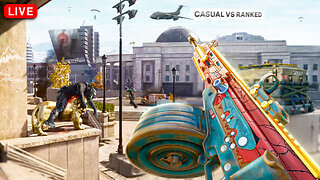Premium Only Content

HOW IT WORKS_ The International Space Station
ISS: The acronym for the International Space Station, a permanently inhabited, government- and industry-supported space station in low Earth orbit.
Modules: The cylindrical, pressurized sections that make up the main body of the ISS, where the crew lives and works, and where experiments are conducted.
Solar arrays: The large, wing-like structures that extend from the ISS truss and collect energy from the sun, converting it into electricity for the station.
Truss: The long, central backbone of the ISS that supports the solar arrays and other components.
Robotic arm: The mechanical arm that can move along the truss and assist with the assembly and maintenance of the ISS, as well as the transfer of cargo and crew.
Docking ports: The openings on the ISS modules that allow spacecraft to attach and detach from the station, enabling the exchange of crew and supplies.
Cupola: The dome-shaped window module that provides a panoramic view of the Earth and space, as well as a control station for the robotic arm.
Microgravity: The condition of very weak gravity that exists inside the ISS, allowing objects and people to float freely.
Orbit: The path of the ISS around the Earth, which takes about 90 minutes to complete.
Expedition: The term for the long-duration missions of the ISS crew, which typically last six months and involve various scientific and educational activities.
-
 LIVE
LIVE
Sean Unpaved
1 hour agoRivalries, Agitators, and Regrets: The Key to Feuds, Dillon Brooks' Impact & the Ultimate Do-Over
323 watching -
 LIVE
LIVE
StoneMountain64
44 minutes agoCasuals > Ranked ... I said it
440 watching -
 1:04:37
1:04:37
Timcast
2 hours agoTrump SLAMS Democrats Over IMPEACHMENT After CEASEFIRE Holds
157K150 -
 LIVE
LIVE
Simply Bitcoin
2 hours ago $0.52 earnedWW3 CANCELLED: $250,000 By 2026 CONFIRMED!! | EP 1273
229 watching -
 LIVE
LIVE
Viss
1 hour ago🔴LIVE - Learn The Tactics You Need To Dominate Battle Royale - PUBG
160 watching -
 1:57:39
1:57:39
Steven Crowder
4 hours ago🔴 You've Been Lied To
391K326 -
 1:02:29
1:02:29
The Rubin Report
3 hours agoTrump Goes in Expletive-Filled Tirade Over Israel & Iran Messing Up Ceasefire Agreement
120K39 -
 LIVE
LIVE
Flyover Conservatives
3 hours agoSettler vs. Immigrant: The Language War That Rewrites History - Wade Stotts | FOC Show
389 watching -
 LIVE
LIVE
TheAlecLaceShow
1 hour agoGuest: Dinesh D’Souza | Trump Drops F-Bomb on Israel & Iran | MAGA Divided | The Alec Lace Show
102 watching -
 LIVE
LIVE
Rebel News
1 hour agoCarney's 'new world order', Smith launches Alberta Next panel, Trump the peacemaker | Rebel Roundup
390 watching